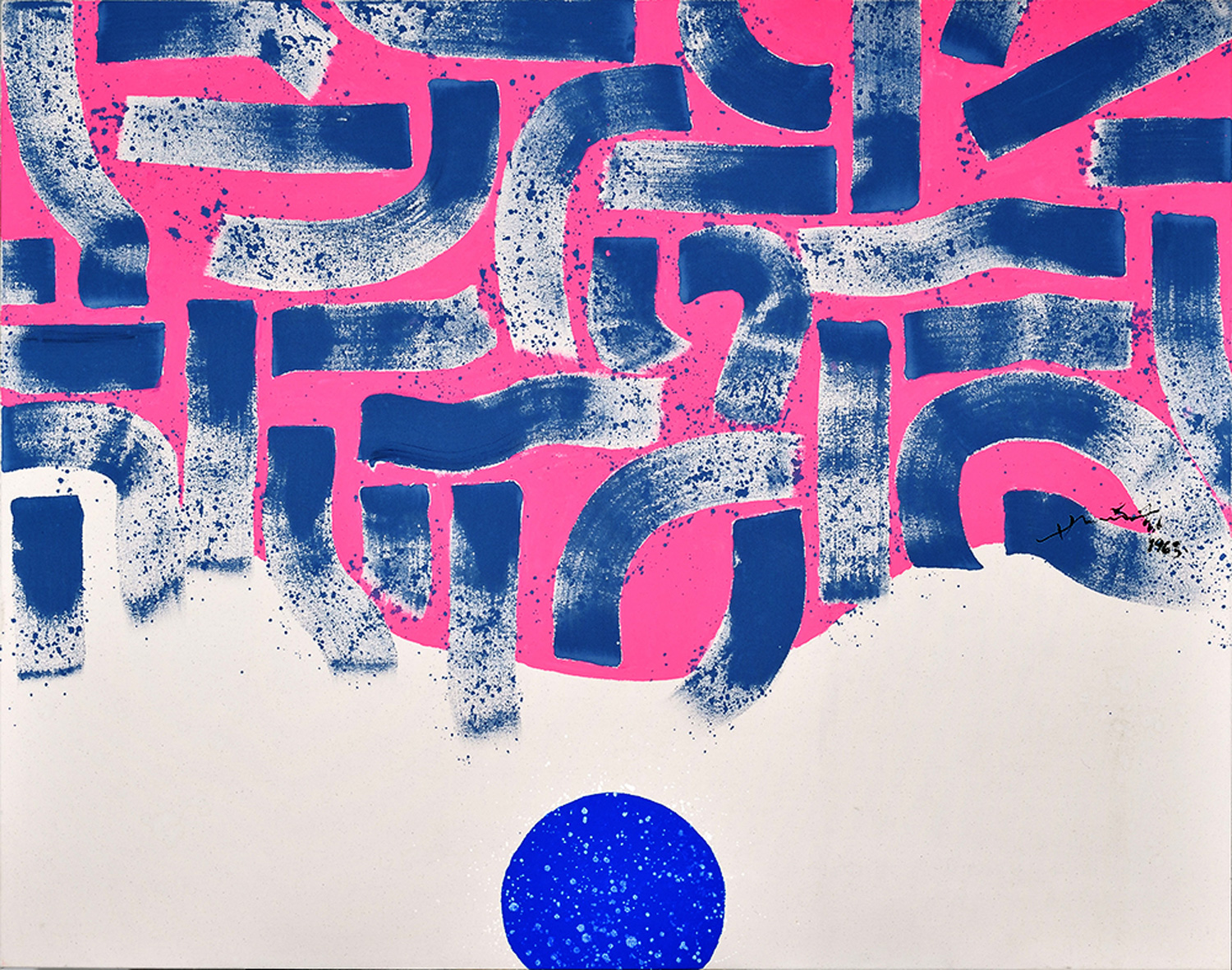Given that pink does not feature explicitly on the electromagnetic spectrum, its appearance in nature is rare and requires a certain bend of light that causes the commingling of red and violet. That said, there is nothing unnatural about the tide of vivid pink that flows from the top of Hsiao Chin’s acrylic-on-canvas abstractions. The pieces’ color derives its vibrancy from surges of short, wide, deep-blue brushstrokes that bend and curve across the works. In Movement of Light (1963), for example, dynamic forms seem to ebb and flow in response to a full, indigo-colored moon that rises from the bottom of the canvas. It is impossible to take in the painting and not feel the energy of its fluid shapes.
At 80 years, Hsiao is as energetic as the hues and brushstrokes that grace his canvases. The Chinese artist is cordial and was quick to laugh when we met on the eve of the opening of his solo exhibition, “Hsiao Chin: 60 Years of Abstraction, Harmony and Form,” at de Sarthe Gallery in Hong Kong. The show displays 18 works, spanning from 1955 to 2004, and is the most recent in a long string of consecutive retrospective exhibits of the artist since the early 1990s. Hsiao told me that he takes each as an opportunity to re-examine his artistic path and facilitate the viewers’ understanding of it. There is a certain circularity that comes with reflecting on his oeuvre, given that he considers each of his works a pure manifestation of reflection itself.
“I am not a pure painter; my practice is spiritual research. I don’t do it purely for amusement,” says Hsiao. This statement rings true and the ideas expressed in it are especially evident in Connection (1963). Using acrylic on canvas, Hsiao depicts a pair of planets in rich pink. They are bridged by two pastel-blue brushstrokes painted at the work’s epicenter, which seems to portray either total union or division. Each color in Connection is—as Italian art historian Arturo Carlo Quintavalle described in his 2008 book Hsiao Chin—“symbolically charged” by delicate splashes of slightly paler gradations. The painting originates from a period during which Hsiao was engaging with Buddhist literature and endeavored to portray universal life forces in his works. Despite such focus on transcendence, the near-geometric shapes in Hsiao’s works have caused some to misinterpret the influence of American hard-edge painting—such as the austere shapes and full colors favored by nonfigurative artists such as Ad Reinhardt and Ellsworth Kelly. Though Hsiao understands the comparison superficially, he insists that his work flouts the genre in that it is wholly “intuitive, not mathematical.”
The artist has traveled to both the European and American continents to enrich his artistic practice, but denies that his work is anything but Chinese. Since his departure from Taiwan to Spain at age 20, Hsiao remained determined to tether his work to his national identity, in keeping with the Ton-Fan abstract art collective he co-founded that particularly focused on Zen and Taoist teachings. “I was trying to enrich myself by examining other peoples’ work, not so I could copy them but so I could distinguish myself from them. I realized that when you go to Europe, if you don’t have your own identity, you will get lost.”
In 2004, Hsiao returned to the traditional Chinese medium of ink on paper, with Untitled-101. The work’s large, blank space recalls the time-honored Chinese liubai technique, but is contrary in that it does not depict anything material, such as air or water. Instead, the bare space lends weight to the centerpiece image of the work: a black, tightly spun swirl that Hsiao achieved in a single, smooth stroke of ink. Regarding the extreme contortion of the wrist required to achieve the effect, the artist says, “It is not a question of technique. You have to use your mind to control the act. If I can think it, I can do it.” Emanating from the whirl of ink are bold dabs of primary color that form a smooth arc across the paper. Like all of his works on show, Hsiao’s brushstrokes here are a moving meditation, his color choices intuitive and his justifications profound. When further probed about his technical choices, he smiles and explains gently, “If I could tell you exactly the why and how in words, I would be a writer, not a painter.” Upon taking in his exhibition in de Sarthe’s gallery room, one is delighted that he is, in fact, the latter.
“Hsiao Chin: 60 Years of Abstraction, Harmony and Form” is on view at de Sarthe Gallery, Hong Kong, until June 27, 2015.
